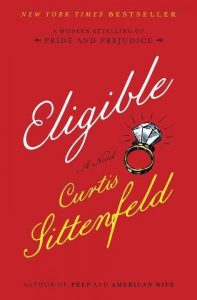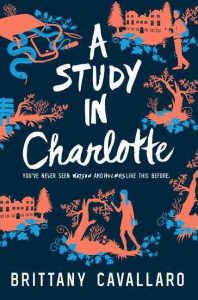 Done right, book adaptations are one of my favorite things to read. What’s not to love about revisiting favorite characters in a different setting, or with different life experiences, or even just at different ages? Although breathing life into original characters is hard work, tweaking well-loved fictional characters so that the source material’s fandom doesn’t come at you with torches and pitchforks is just as difficult. An author has to expand the established canon without destroying it, upsetting fans, or pushing the story that much outside of what’s expected that it’s no longer really an adaptation. (Hi, Fifty Shades of Grey.) Sherlock is one of my favorite shows and Joe Wright’s Pride & Prejudice is one of my favorite films – which is why I was actually quite excited about reading both A Study in Charlotte and Eligible.
Done right, book adaptations are one of my favorite things to read. What’s not to love about revisiting favorite characters in a different setting, or with different life experiences, or even just at different ages? Although breathing life into original characters is hard work, tweaking well-loved fictional characters so that the source material’s fandom doesn’t come at you with torches and pitchforks is just as difficult. An author has to expand the established canon without destroying it, upsetting fans, or pushing the story that much outside of what’s expected that it’s no longer really an adaptation. (Hi, Fifty Shades of Grey.) Sherlock is one of my favorite shows and Joe Wright’s Pride & Prejudice is one of my favorite films – which is why I was actually quite excited about reading both A Study in Charlotte and Eligible.
Until I stopped reading Brittany Cavallaro’s YA novel 28% of the way through and reluctantly finished Curtis Sittenfeld’s modern retelling and was like ¯\_(ツ)_/¯. For both novels, there were too many annoyances that took me out of the story and straight into some variation of “why????” For instance, in only a couple of chapters of A Study in Charlotte, I already had a list of questions: Why does Jamie Watson suddenly have Hulk level anger fifteen pages into the story? (Because that anger needs to move the plot forward??) Why do Jamie and Charlotte call each other Watson and Sherlock at sixteen years old? (Because we need our main characters to??) Why did Cavallaro set her novel in a boarding school? Why sixteen and not eighteen? Why high school and not college??
And Eligible… #groan. Why did Sittenfeld change Charles to Chip but keep Fitzwilliam? Why does everyone call Bingley Chip but call Darcy Darcy? Why does William Collins still kiss Lizzy and propose marriage even though they’re step-cousins? (It’s still weird, okay, even if they’re technically not related.) Why does Charlotte move to California to live with Collins when they’re practically strangers? (Because Lizzy has to visit someone in order to meet-cute Darcy at Pemberley??) Why is Mrs. Bennet such a homophobic racist and Mr. Bennet such a stick in the mud about single parenthood? Why is Lydia’s marriage such a horrible awful thing???¹
I don’t consider myself a capital-F fan of Sherlock Holmes, but I am one toward Pride and Prejudice. The push and pull relationship between Elizabeth Bennet and Fitzwilliam Darcy is akin to a sacred text. Get it right (I’m looking at you, The Lizzie Bennet Diaries) and I’m in a fangirl puddle over what’s going to happen and are Lizzy and Darcy going to get together and how is everything going to work out??? But get that dance wrong? Change just enough details in the wrong way? Suddenly it’s an affront to all things good and pure.
 I understand that both Sherlock Holmes and Pride and Prejudice are in the public domain and so authors can do with it what they will, but, to me, neither A Study in Charlotte nor Eligible succeeded as a “modern retelling” of nineteenth- and eighteenth-century novels, respectively. In some instances, Cavallaro and Sittenfeld took the overarching themes of Conan Doyle’s and Austen’s novels and reworked them to make sense in the twenty-teens… and then, in other instances, they simply rehashed plot points to fit within the narratives even when they didn’t make sense. (For example, why make Charlotte Holmes and Jamie Watson direct ancestors of Holmes and Watson? Why not just make these new iterations the only Holmes and Watson? We already know they’re supposed to be facsimiles. Why not have plot points come naturally to the characters instead of forcing the characters to work around pre-determined plot points?)
I understand that both Sherlock Holmes and Pride and Prejudice are in the public domain and so authors can do with it what they will, but, to me, neither A Study in Charlotte nor Eligible succeeded as a “modern retelling” of nineteenth- and eighteenth-century novels, respectively. In some instances, Cavallaro and Sittenfeld took the overarching themes of Conan Doyle’s and Austen’s novels and reworked them to make sense in the twenty-teens… and then, in other instances, they simply rehashed plot points to fit within the narratives even when they didn’t make sense. (For example, why make Charlotte Holmes and Jamie Watson direct ancestors of Holmes and Watson? Why not just make these new iterations the only Holmes and Watson? We already know they’re supposed to be facsimiles. Why not have plot points come naturally to the characters instead of forcing the characters to work around pre-determined plot points?)
I gave up on A Study in Charlotte, but I did power through Eligible. With every Pride and Prejudice retelling, a familiar reader will basically know in what situation the Bennet sisters will find themselves by the end of the story. But I was wholly underwhelmed with Sittenfeld’s specifics, and my takeaway was: would I have kept giving her novel unlimited chances to get better if it wasn’t a Pride and Prejudice retelling? The answer, unfortunately, turned out to be no, no I wouldn’t have.
¹ SPOILER SPOILER SPOILER
Sittenfeld turns Wickham into Jasper Wick and makes him a total cad toward Lizzy only. The big blowup that spurs Darcy into white-knighting Lydia’s hush-hush marriage deals with her boyfriend Ham’s transgender status. My annoyance came not with Ham being transgender but with how many times Sittenfeld used the word in the span of two pages. After this “big reveal,” I just wanted the story to move forward. Like, I understand that Ham is trans…but, so what? He loves Lydia and she loves him. They are adults. They can legally get married. Why are you making such a big deal out of this????


